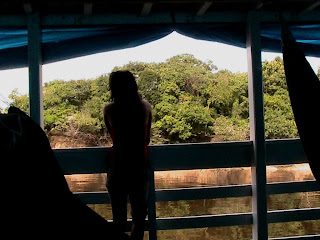Houses on stilts, ready for rising water levels, near the Sao Raimundo passenger boat port.
Boats on a polluted creek, seen from a bridge.
Genesis III (the boat I was about to take) and the pontoon café/ convenience store.
The other boat heading upstream- bigger, busier and with blaring Forró music.
Nylon cord and foodstuffs, essential for a long boat trip.
Departure.
Sun sets as we pass under a huge bridge being built over the Negro.
The upper sleeping deck.
View from my hammock.
The following morning, close to a river bank.
The speedboat used to take people ashore to villages along the way.
On-board entertainment.
View from the kitchen.
Looking out.
A fishing boat heading upstream- one of only three boats we passed in 30 hours.
Captain.
Amazon state flag on the prow of the boat.
Sleeping, the most popular way to pass the time on board.
Looking down.
One of a handful of villages passed in this thinly inhabited part of the Amazon.
Manioc, the staple food of the Amazon.
View from the stern.
Lucas, who took a shining to my camera.
Antoniwe writing his name on my netbook, with Lucas looking on.
Serene river.
A pair of macaws way up high.




















































